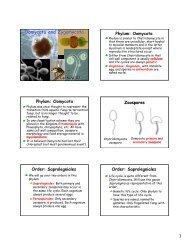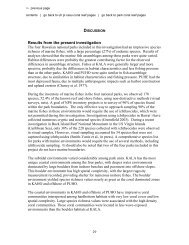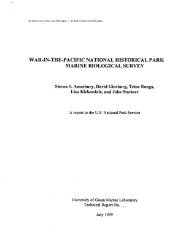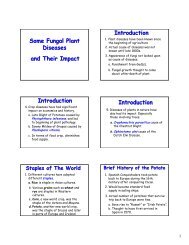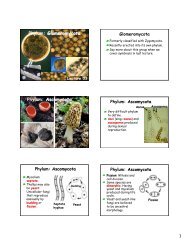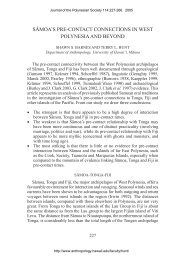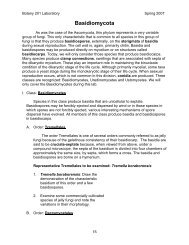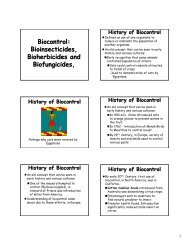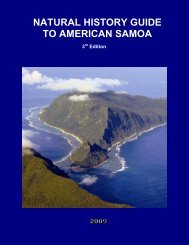american samoa - University of Hawaii at Manoa Botany Department
american samoa - University of Hawaii at Manoa Botany Department
american samoa - University of Hawaii at Manoa Botany Department
- No tags were found...
Create successful ePaper yourself
Turn your PDF publications into a flip-book with our unique Google optimized e-Paper software.
WETLAND RESTORATION AND ENHANCEMENT STRATEGIESGeneralThere are two potential opportunities for the restor<strong>at</strong>ion and enhancement <strong>of</strong> the Fusi wetland.The scope <strong>of</strong> these restor<strong>at</strong>ion and enhancement opportunities and rel<strong>at</strong>ed implement<strong>at</strong>ionstr<strong>at</strong>egies are presented in the following paragraphs.The potential benefits and impacts derived from the implement<strong>at</strong>ion <strong>of</strong> each str<strong>at</strong>egy aresubsequently compared and evalu<strong>at</strong>ed. This analysis provides the basis for the selection <strong>of</strong> arecommended restor<strong>at</strong>ion or enhancement str<strong>at</strong>egy.Preliminary cost estim<strong>at</strong>es are presented for the implement<strong>at</strong>ion <strong>of</strong> the recommended str<strong>at</strong>egy.Long-term monitoring and site maintenance requirements associ<strong>at</strong>ed with the recommendedstr<strong>at</strong>egy are also identified.Altern<strong>at</strong>e Opportunities and Str<strong>at</strong>egiesOption 1: Remove Solid Waste M<strong>at</strong>erial and Plant Wetland Marsh Veget<strong>at</strong>ionBiosystems Analysis, Inc. suggested in 1993 th<strong>at</strong> the best opportunity for wetland restor<strong>at</strong>ion inthe Manua Islands was restor<strong>at</strong>ion <strong>of</strong> the Fusi wetland. The initial requirement for therestor<strong>at</strong>ion <strong>of</strong> the former coastal marsh would be the excav<strong>at</strong>ion <strong>of</strong> solid waste m<strong>at</strong>erial via theprimary use <strong>of</strong> bulldozers, front-end loaders, and trucks (Figure 11-3). Required heavyequipment can probably be obtained from Tau-based, oper<strong>at</strong>ing divisions <strong>of</strong> ASPA and/or theASG <strong>Department</strong> <strong>of</strong> Public Works. Secondarily, some smaller m<strong>at</strong>erials would be retrievedmanually. Subsequently, excav<strong>at</strong>ed m<strong>at</strong>erial would be hauled by truck to the public solid wastelandfill situ<strong>at</strong>ed northeast <strong>of</strong> Tau High School.Bulldozers and front-end loaders would subsequently be used to re-grade the site to thecontours th<strong>at</strong> were generally identified on 1990 topographic maps for the Fusi area and removeremaining portions <strong>of</strong> the beach hibiscus thicket. ASCC Land Grant personnel would be usedto plant some 50 utuutu (w<strong>at</strong>er chestnut), 25 vao tuaniu (marsh fern), 25 selesele(Rhynchospora corymbosa), and 25 sa<strong>at</strong>o (swamp fern).Option 2: Remove Solid Waste M<strong>at</strong>erial and Establish Taro ProductionSimilar to Option 1, the initial action associ<strong>at</strong>ed with the restor<strong>at</strong>ion <strong>of</strong> the former coastal marshwould be the excav<strong>at</strong>ion <strong>of</strong> solid waste m<strong>at</strong>erial via the primary use <strong>of</strong> bulldozers, front-endloaders, and trucks. Required heavy equipment can probably be obtained from Tau-based,oper<strong>at</strong>ing divisions <strong>of</strong> ASPA and/or the ASG <strong>Department</strong> <strong>of</strong> Public Works. Secondarily, somesmaller m<strong>at</strong>erials would be retrieved manually. Subsequently, excav<strong>at</strong>ed m<strong>at</strong>erial would behauled by truck to the public solid waste landfill situ<strong>at</strong>ed northeast <strong>of</strong> Tau High School.Existing veget<strong>at</strong>ion within the wetland would also be cleared to enable use <strong>of</strong> the wetland forfuture taro production. W<strong>at</strong>er required from taro production would be derived from rainfall, aswell as limited surface w<strong>at</strong>er flows from the steeper slopes east <strong>of</strong> the wetland.American Samoa Wetlands/Streams Restor<strong>at</strong>ion and Enhancement PlanFebruary 2001, Fusi Wetland, Page 11-7



